From Boston College Magazine. Photographs by Lee Pellegrini.
This year, between late June and Labor Day, more than a million prospective college students—rising juniors and seniors for the most part—will set out across the United States, most accompanied by their parents, to seek experiences of the colleges they have long contemplated in guidebooks, brochures, on websites, and in counsel with high school guidance professionals and friends.
At Boston College, some 30,000 visitors (including parents, siblings, and the occasional grandparent) will turn up over the summer at the Office of Undergraduate Admission, in Devlin Hall, to attend informational presentations, join in Q&A sessions with undergraduate panels, and take tours of the Middle Campus led by backwards-walking students who have memorized a great deal of information. On June 28, 2016, a sticky, overcast Tuesday—10 years after I and my parents made a similar visit to Boston College—I tagged along from 9:00 a.m. to 4:30 p.m. as 580 individuals sought direct experience of the University and the answers to some questions they hadn’t been able to resolve by reading U.S. News & World Report or bc.edu:
- Could my daughter have a byline in a biology research journal in her freshman year?
- Where and when is Mass held on weekdays?
- Is your management school Bloomberg-certified?
- When did this place start to feel like home?
Most visitors on this day appear eager, but others seem wearied, perhaps by the previous day’s cross-country flight, or hours on the college-tour bus (next stop, MIT). Young children accompany some families, blasting plasma beams into zombies on iPhones while waiting for the next meal break. Most parents and their high schoolers will spend two hours at Boston College. During the first, they’ll attend an “Eagle Eye Information Session” led by an admission staff member and featuring student panelists; during hour two they’ll take a walking tour of about a dozen Middle Campus locations.
Three weeks earlier, John L. Mahoney Jr. ’79, director of undergraduate admission since 1990, gave his annual pep talk to this summer’s 18 student panelists and tour guides. The students had been selected from more than 100 interviewed applicants for their institutional knowledge, charisma, public speaking skills, and collective demographic and academic diversity. Over 12 weeks, they would be paid $11 an hour to “act as the voice of our 9,100 undergraduates,” says Mahoney.
Visitors “will look to you and think you’ve got the key. Especially families going through [the admission process] for the first time; they think you have wisdom they could never hope to have.” He paced back and forth at the front of a Devlin lecture hall with his hands clasped behind his back. He noted that a majority of visiting prospects will have just come from, or will be on their way to, tours of Harvard, Brandeis, Wellesley, Northeastern, Boston University, Tufts, or Emerson. Many will visit five, and some even 25 colleges. “Yours is serious, important work, with huge ramifications for BC.” He told the students that while he and his staff will travel in the fall to pitch the University at more than 1,000 high schools in the Americas, Europe, and Asia, “we have just one opportunity to make a great first impression.”
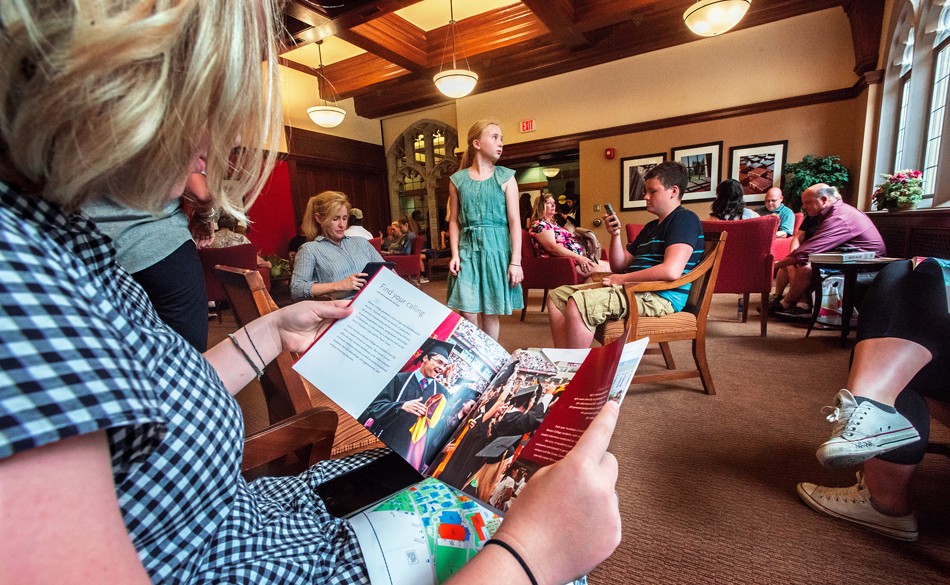
On June 28, the work begins at 9:00 a.m., when teams “South End,” “Cambridge,” and “North End” report for their weekly half-hour review in Admission’s Devlin Hall conference room. These summer teams are made up of six students each. (The assignments are shuffled and the teams are renamed every three weeks to keep the work fresh. The previous week’s teams were named after Hillside Café sandwiches.) During this week’s review, the students share visitors’ questions from the past week that stumped them, and admission staff Kayte Hager ’08 and Zach Wielgus ’11 help them find answers so they won’t be stumped again. Where’s the crew team’s boathouse? (On the Charles in Newton, three miles from campus.) What did Wallace E. Carroll ’28, H’57, the School of Management’s namesake, do? (He was a bricklayer’s helper who went on to found a manufacturing conglomerate.) One mother had asked for the University’s suicide rate. Suicide, while not unknown at Boston College, is very rare. The admission staff members review with the students the University’s mental health services and referral systems for faculty and staff.
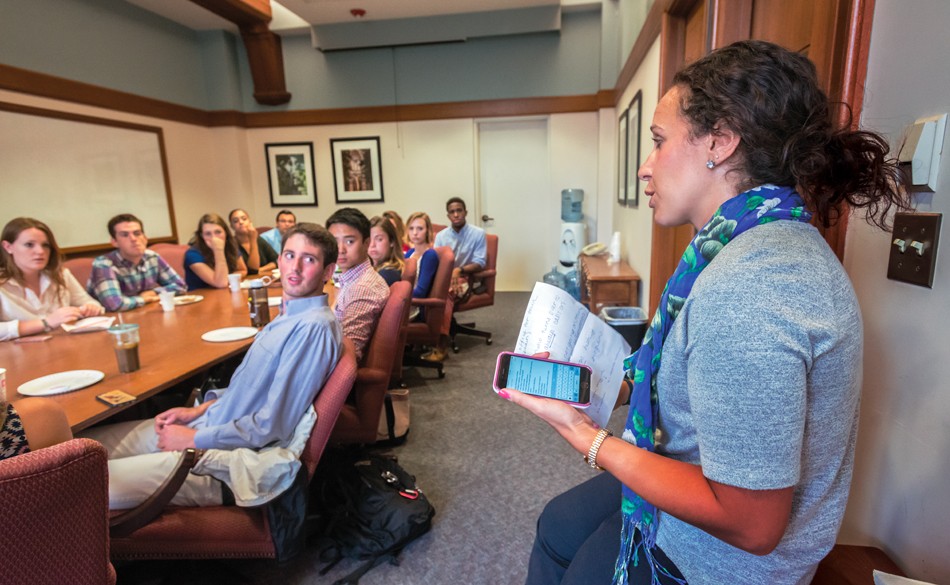
By 9:20, more than 100 parents and their teenagers have crowded into the Office of Undergraduate Admission’s greeting room next door, spilling into the lobby. Some watch footage of the campus on a flat-screen between the arched windows. Others read brochures. Half a dozen gather around the receptionist, asking about TOEFL scores for international students, study abroad programs, and how to validate their parking.
By 9:30, the visitors are in Gasson Hall’s auditorium. They sit beneath portraits of 24 past presidents of Boston College. Some parents have notebooks in their hands. Some will end up writing on napkins or the backs of BC Bookstore receipts. A toddler at the rear of the room stretches out across three chairs. And then associate director of admission Susan Migliorisi ’93, a one-time English major who’s been with the admission office since 1999, opens the proceedings with a 15-minute overview of the University and its mission.
She describes the core curriculum, referring to it as an opportunity to “explore different parts of yourself. Even if you know you want to be an accountant and not a scientist.” She adds, “Ultimately, we want to help students figure out who they are and what they can do to make the world a better place.” (Wielgus echoed this when he led the 1:00 info session, noting that the core is designed to “cultivate intellectual curiosity” and “broaden your skillset. Down the line, if you change your job, or even your career, you won’t be starting from scratch.”)
Migliorisi concludes her brief presentation with a Boston College parable. It’s the story of Kat (Wakeham) Barnes ’07. One evening during her freshman year, Wakeham was in the Flynn RecPlex, reading a book on HIV/AIDS while on a treadmill. The man on the treadmill beside her turned out to be theology professor James Keenan, SJ. Seeing her book, he told Barnes, “You need to take my course, ‘Ethical Issues of HIV/AIDS’.” So began a mentorship, “one of the hallmarks of Boston College,” Migliorisi notes. “Faculty connect with our students to foster academic and personal development.” Barnes became a biology major, interned with a medical missionary program in Tanzania, worked with the Jesuit Volunteer Corps, and graduated from Harvard Medical School. She’s now a family physician in Seattle.
Five members of Team South End then walk single-file to director’s chairs set up in front of the room. Each introduces himself or herself by recalling a formative Boston College experience. Will Pisano ’18, in his central Florida drawl, talks about researching Toxoplasma gondii, a common parasite in developed nations. (His byline is slated to appear in a science journal later this year.) Diana Dinkel ’19, a Michigander in the Lynch School of Education, recounts her 48 Hours retreat—two days of reflection for first-year students, on Cape Cod—where she “realized everyone was going through the same transition, and was just as vulnerable and homesick as I was.” (This prompts sympathetic nods from audience members, parents and offspring alike.) Bronx native and finance and business analytics major Isaiah Cyprien ’19, sporting a sky-blue Oxford, Nantucket red pants, and a flat top, talks about “finding a home outside the classroom” with a student-run consultancy for startups in Boston. When he uses the phrase “real deliverables to real businesses,” at least two mothers shoot their sons raised- eyebrow looks of, Well, doesn’t that sound practical?
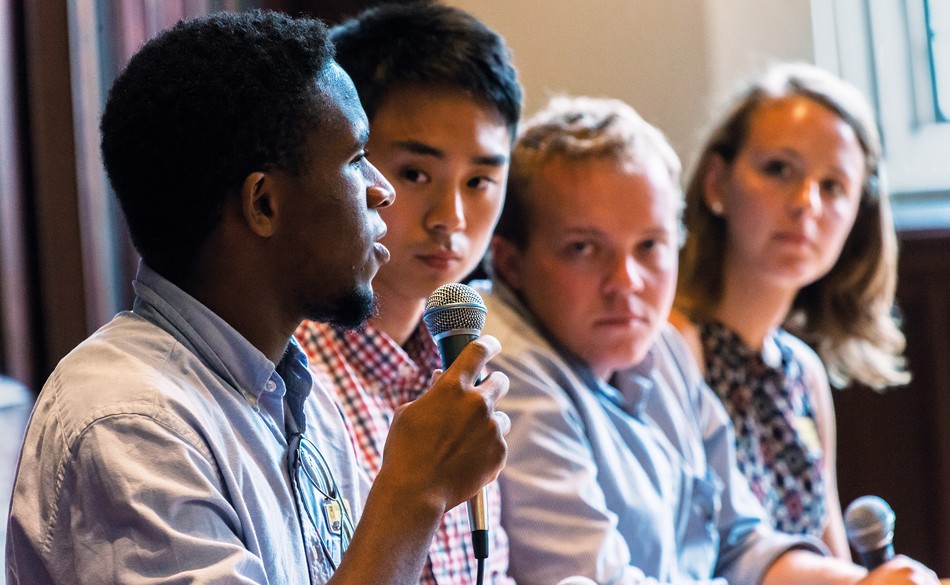
Whether nervous about asking the wrong question or uncertain about what they need (or want) to know, high schoolers asked only nine questions during the three info sessions I attended. Parents posed 37. A mother asked if a student can have two majors in the Carroll School and minor in Spanish. (Yes.) A father asked about sports. (Panelists mentioned the varsity teams, intramural teams, and the tradition of “packing the T” en route to the Beanpot hockey tournament downtown, so there’s no room on the train for Boston University students.) Another father pitched a question each guide will hear many times this summer: “Why did you choose Boston College?”
Of the dozen or so colleges she considered, Dinkel replied, only Boston College met all her critical preferences: Catholic, near a city but not in a city, a top-tier research institution, and with Division I athletics. Cyprien admitted that Boston College wasn’t his first choice. “So if you ask me why I came to BC, it’s because I had to.” After the laughter subsided, he said, “I’ll tell you why I stayed. The people.” He mentioned “super involved” classmates, and “incredibly supportive” faculty and advisors.
Wielgus says that the admission office encourages student staff to be honest—to avoid “any whiff of scriptedness.” When accounting and finance major Justin Yun ’18 mentions a summer spent studying in Madrid, during the 9:30 information session, he says, “Quite frankly, I learned less about business law than I did about Spanish night life.”
A girl with a red braided-ponytail asks: “How does BC grow your personal faith, if that’s applicable to you?”
Noting that she herself is Catholic, Dinkel says she’s taken advantage of religious retreat programs and the frequent Masses offered by the University’s chaplaincy and the Jesuit community. She adds that “even some of my atheist friends” treat the Jesuits who live in the residence halls as confidants.
“As someone who’s not religious at all,” says Cyprien, “I’m grateful I’m able to benefit from the aspect of reflection without feeling like my beliefs are [intruded upon].”
Throughout the day, students and admission staff frame Jesuit higher education as offering particular religious development opportunities for Catholics and supporting religious or spiritual development among all students. In the 1:00 info session, Wielgus tells the Gasson Hall assemblage, “This is not a place where you’re going to be asked, Are you Catholic? This is a place where you’re going to be asked, What do you believe in, and why do you believe in it? Have you thought about religion? Have you thought about spirituality? Why? What do you value in your life?”
Following the 9:30 session’s Q&A, Migliorisi runs through the application process. Parents scribble furiously.
10:30: Team Cambridge arrives to lead a set of tours. The students have prepared for this work by studying a 40-page handbook of University history, data, and tips on answering common questions (e.g., Do students feel safe on campus at night?). They also observe a loose on-the-job dress code (no acid-washed jeans, no gear from another college). But they’re encouraged to design their own routes through the Middle Campus and tell their own stories.
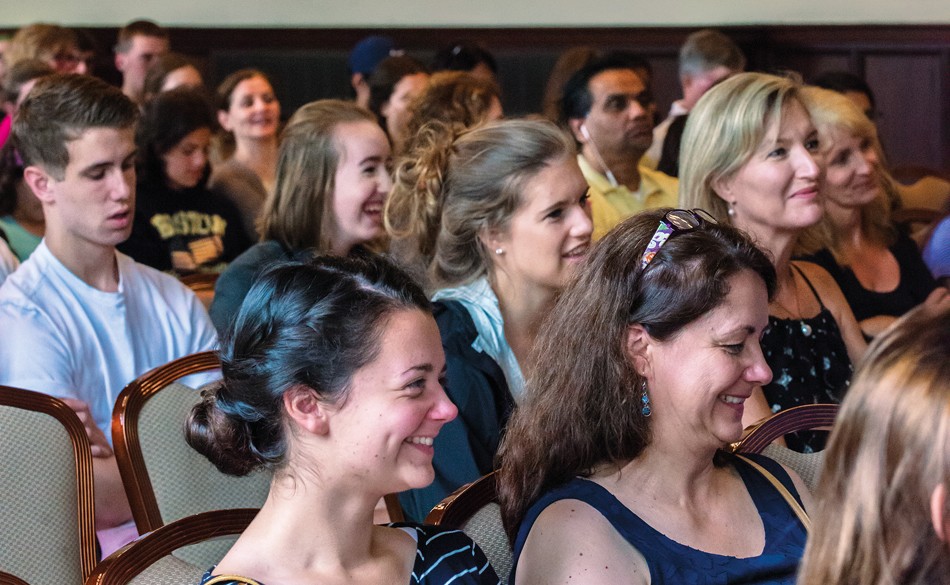
Max Bechtold ’18, a chipper, red-headed history major, greets his tour group of 20 in the Gasson rotunda. After a quick review of the University’s origins as a school for the poor sons of immigrants, the Connecticut native leads the visitors out towards the Stokes Green (gesturing back to the spires of the “most Instagrammed academic building in America”). Noting that the University supports no fraternities or sororities—information that always seems to draw a choral hmm from tour groups—Bechtold adds, “Our 280 clubs are the pulse of the campus. [But] if you can’t find one that’s right for you, you can start your own.” He notes that in 2015 he and friends founded the Common Tones, a co-ed a cappella group.
Between stops on Bechtold’s tour, teens and parents converse quietly, and it’s possible to make out Portuguese, Mandarin, and Hindi. A mother from Los Gatos, California, murmurs to another mother, “We’re on an East Coast swing, but we really hope he doesn’t go somewhere this far.” Another mother, from Concord, New Hampshire, says to a father, “We’re relieved the drive wasn’t bad at all. I think we can make this happen.” (Throughout the day, high schoolers refer to themselves as “I”; parents almost invariably say “we.”) Mid-tour, Bechtold leads his group into a first-floor classroom in Stokes Hall and invites them to sit and imagine themselves in a seminar. Then, “in the Jesuit spirit of reflection,” he asks the prospective students to share a “high and low” moment of the week. Most lows are the long hours in a car—one girl was touring Boston College, Harvard, and Tufts today, Brown and Providence College the following day, and Columbia and NYU the day after that. Ben, a rising senior from Los Angeles, says, “My high was probably flying my little cousins yesterday on the Cape.” The group looks confused. His father clarifies: “He’s a pilot.” If Ben intended to impress his fellow prospects, he did.
Bechtold leads his group to McElroy Commons, where he explains housing and meal plans. He notes that male students, discovering that they’ve drained their meal card investments before the semester ends, will look to have dinner with women friends, who often still have funds. “It’s kind of how dating works here at BC,” he jokes. Before the day’s out, I will hear three other guides tell pretty much the same joke. Bechtold stops his group in front of the statue of St. Ignatius to talk about the core curriculum and then leads them into the Higgins atrium for a conversation about undergraduate research opportunities. He ends his tour atop the Higgins Stairs, overlooking Conte Forum and Alumni Stadium, and tells the prospective students that if they enroll at Boston College they’re “bound to enjoy better luck” with athletics than he and his fellow Eagles experienced last year. He wishes the students success in applying to college, the group applauds, and the majority quickly disperse, some back to the Admission Office, some to the bookstore, some to the next college.
11:45: Team South End’s tour groups amble out of Gasson. I join about 30 people following Dinkel. It quickly becomes apparent that each tour takes on the character of its student leader. The soft-spoken Dinkel prefaces her tour by saying, “My job isn’t to sell you BC, to tell you it’s the best place in the world, or even to try to get you to apply. My job is to give you the most authentic tour possible.”
As we strolled past laboratories in Higgins Hall, a mother asks about the strength of the premed track. Dinkel responds that 85 percent of Boston College students who achieve the average MCAT score are accepted into medical school. She highlights the research apprenticeships available through the Undergraduate Research Fellows program. She also mentions science-specific service trips—Dinkel’s classmate had spent a week in Nicaragua in May with a Boston College medical assistance team—and internship opportunities in “one of the best hospital towns in America.”
Between days working as an admission guide, Dinkel adds, she’s volunteering at Brigham and Women’s maternity ward this summer.
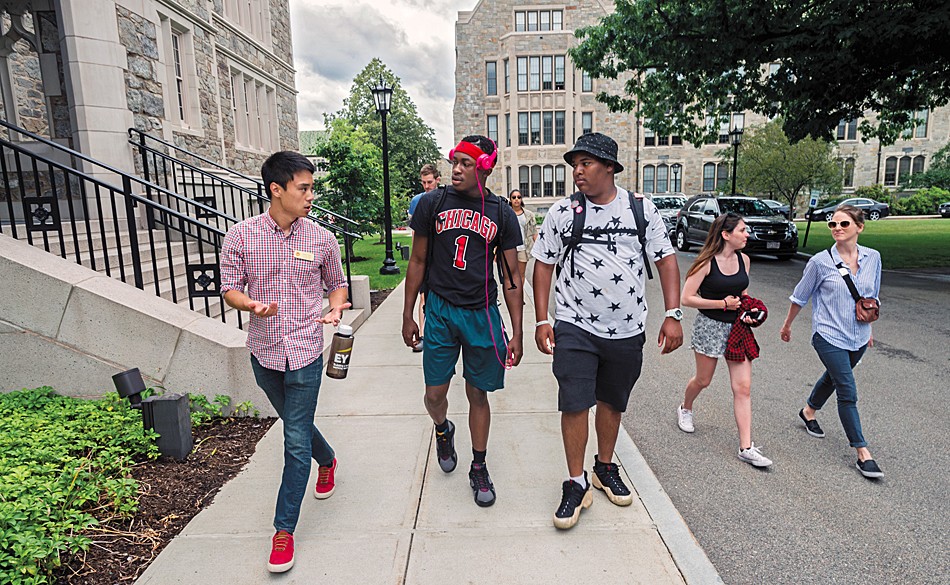
1:00: A fresh influx of 100 or so visitors packs the Devlin 101 amphitheater for the third info session. A rising junior with a robust Afro, visiting with 15 classmates from Coney Island Prep in Brooklyn, asks the panel how applicable the courses are to future careers. A mother with a Southern accent asks, “How do you manage the winters?” A high schooler from Birmingham, Alabama, is flanked by her parents, three younger siblings, and grandparents. Grandma asks, “How has Boston College changed you, and what facilitated that change? The students? The faculty? The classwork? The mindset?”
“The Jesuit aspect of reflection has definitely changed my life,” responds Nicole Rodriguez-Rowe, a rising Lynch School sophomore from Clifton, New Jersey. She mentions that at the start of every session of her first-year seminar, “The Courage to Know,” her Jesuit faculty member turned off the lights for five minutes and asked students to reflect on a series of questions in silence: “Were you kind to someone today? Jealous? If you could do today over, what would you do the same? What would you change?” The class’s emphasis on introspection sparked an interest in applied psychology and human development, which is now her Lynch School major, she says; and it encouraged her “to think about the life that I’m living semester to semester, moment to moment.”
Finance major Courtney Severance ’19 responds that “extremely accessible professors” helped her when she found her confidence challenged by the move from her Wisconsin high school, where she was a top student, to a school where “basically everyone was at the top of their high school class.” And she mentions the assigned readings in philosophy (Plato, Aristotle, Kant) in the Carroll School’s Portico class for freshmen that helped shape an “ethical foundation” for her business aspirations.
2:00: Team North End takes over for the penultimate tour, and a Groundhog Day effect kicks in. We are back under the Stokes archway learning about the difference between internal and external study abroad programs. There’s another mom draping her arm around her son’s shoulder when the guide mentions the three-pronged reflection familiar to many Boston College students: “What do you value? What are you good at? And does the world need you to do it?” Here we stand again in Fulton Hall, hearing that the architect of the atrium was inspired by The Wizard of Oz—the conical lamps a nod to the Tin Man’s hat, the ruby tiles a reference to Dorothy’s slippers. The undergraduate guides are air tight with most of their facts, and Wielgus and Hager often drop in on tours to make sure. But the Oz story is pure tour guide folklore, passed down at least since I first visited campus a decade ago.
Omnipresent throughout the day is John Mahoney. I see his head appear in the doorway behind the podium during the 9:30 panel, assessing the crowd. He brings Team North End into a huddle before their 10:45 panel. He comes into view again outside an arched window of Devlin 101 at 1:45.
4:30: And there he is again, talking with parents in front of Devlin after the final tour. Nearby, a father is asking a guide if there is a way to know how much financial aid the University might provide before his daughter applies (answer: the financial aid office will offer a ballpark figure over the phone). A couple of families sit on the concrete benches of O’Neill Plaza, trading impressions. A son takes a selfie with his father that captures Gasson Hall. A few student guides chat under Devlin’s archway. Today is done. Six-hundred and fifty visitors have registered for tomorrow, 570 for Thursday, and more than 1,000 for Friday.
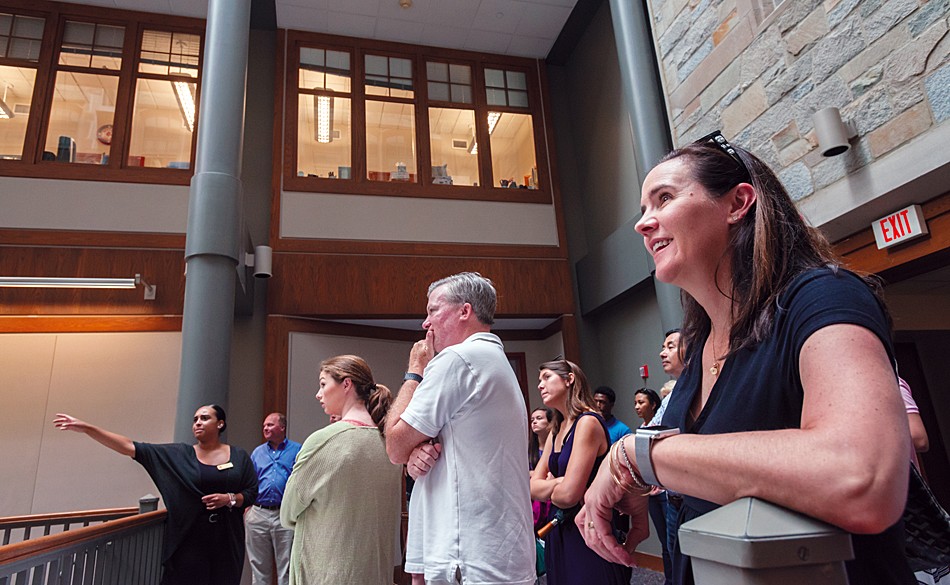
The day’s mission, Mahoney later told me, is not to lure in as many applications as possible. “Especially during summer, we presume students are beginning their college search—collecting information, comparing and contrasting ... They’re trying to learn the culture of the place to see if it would be the kind of place in which they’d like to learn, live, and grow for the next four years. I don’t think they’re even thinking about applications yet.”
Visitors I talked with over the course of the day said they had sought out Boston College because of Boston, because of advice (expert, friendly, and familial), and because of the University’s ranking in U.S. News & World Report, Forbes, the Princeton Review, Bloomberg Businessweek, the Economist, Kiplinger’s, et. al. They heard hundreds of data points over their two-hour stop: the average SAT, SAT II, ACT, AP, TOEFL scores of accepted students; that only 30 percent of applicants are admitted; that for the Carroll School that figure is 22 percent, for the Connell School of Nursing, 26 percent; that 60 percent of freshmen live on Upper Campus; that certain majors require 10 courses, others 12; that Newton is the third safest city in America.
But the college visit is about experience, sights, voices, feelings. A rising senior from Concord, New Hampshire, told me he was impressed by the absolute zero freezer in a physics lab he visited. Others seemed particularly struck to learn that Robert Frost had spoken in Gasson 100, the room they were sitting in; or that dining hall staff at Boston College receive the same employee benefits as tenured faculty; or that Diana Dinkel said her first class at Boston College enrolled “more students than were in my entire high school class” and the faculty member already knew all 120 faces and names on day one.
As Josie, a rising junior from North Carolina, told me, most teenagers visit colleges “looking for a vibe.” She said she’s leery about attending a school so far from home, “but the vibe I got from everyone today is, this is home.”




